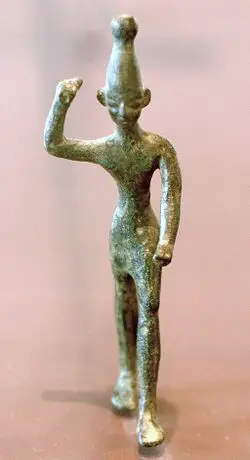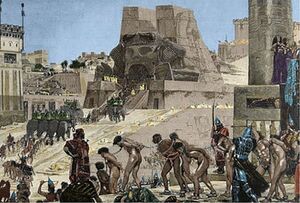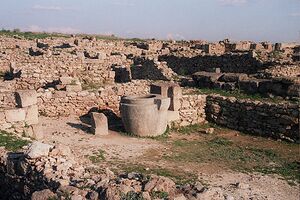Difference between revisions of "How Did the God Baal Become Popular?"
| Line 1: | Line 1: | ||
| − | [[File: Baal_Ugarit.jpg| | + | [[File: Baal_Ugarit.jpg|250px|thumbnail|left|Statue of Baal of Ugarit]]__NOTOC__ |
Among all the ancient Near East's major deities, Baal is perhaps one of the least understood. Much of the modern misunderstanding of Baal comes from passages in the Old Testament of the Bible, where the Israelites would turn from Yahweh to Baal, often with disastrous results. Part of the confusion also comes from the name “Baal,” or “Ba’al,” itself. In many of the Western Semitic languages of the Bronze Age, the word “baal” meant lord and was often used generically. Although the god Baal did become the primary deity in the pantheon of many of the Canaanite peoples and was therefore “lord” of the gods, the generic name was sometimes used to refer to other Canaanite gods, such as El and Dagan. | Among all the ancient Near East's major deities, Baal is perhaps one of the least understood. Much of the modern misunderstanding of Baal comes from passages in the Old Testament of the Bible, where the Israelites would turn from Yahweh to Baal, often with disastrous results. Part of the confusion also comes from the name “Baal,” or “Ba’al,” itself. In many of the Western Semitic languages of the Bronze Age, the word “baal” meant lord and was often used generically. Although the god Baal did become the primary deity in the pantheon of many of the Canaanite peoples and was therefore “lord” of the gods, the generic name was sometimes used to refer to other Canaanite gods, such as El and Dagan. | ||
Revision as of 02:25, 22 July 2021
Among all the ancient Near East's major deities, Baal is perhaps one of the least understood. Much of the modern misunderstanding of Baal comes from passages in the Old Testament of the Bible, where the Israelites would turn from Yahweh to Baal, often with disastrous results. Part of the confusion also comes from the name “Baal,” or “Ba’al,” itself. In many of the Western Semitic languages of the Bronze Age, the word “baal” meant lord and was often used generically. Although the god Baal did become the primary deity in the pantheon of many of the Canaanite peoples and was therefore “lord” of the gods, the generic name was sometimes used to refer to other Canaanite gods, such as El and Dagan.
Baal’s attributes have also been a source of confusion for modern scholars. Since Baal was a weather god often associated with the rain, he was sometimes syncretically combined with the Syrian storm-god Hadad and the Hurrian storm-god Teshub. Baal was also associated with the better-known and more notorious Phoenician god Moloch in some locales and other historical periods. None of this confusion takes from the fact that Baal was one of the most popular and important gods of the Near East. In fact, Baal’s seeming ambiguity may have played a role in his popularity.
Baal’s ambiguity stemmed from the diffusion of his worship by his followers. The ethnic Canaanites who worshiped Baal spread the various manifestations of his cult to the numerous city-states that dotted the landscape of the Bronze Age Levant until he became the most important god in the wealthy influential city of Ugarit. From Ugarit and the Levant, the Phoenicians later took Baal with them when they established colonies throughout the Mediterranean basin.
Who Was Baal?
The precise origins of Baal remain obscure, but it is known that he was a product of the West Semitic people of the Bronze Age. The West Semites were the plethora of Canaanite tribes that built the city-states of the Bronze Age Levant and who were closely related in language and culture to the Hebrews, Moabites, and later Phoenicians. [1] Among the cultural attributes that the Canaanites shared was a similar pantheon, of which Baal was usually among the most important gods.
The Canaanite pantheon, which could be described as “Baal’s family,” was most thoroughly documented at Ugarit. At the head of the pantheon was El, often referred to as “Father of the Gods.” El was the most important Canaanite god earlier in the Bronze Age, but in the Late Bronze Age, he was surpassed by Dagan, the father of Baal, and Baal himself. As was the case in most ancient pantheons, Baal had a consort, named Asherah with whom he shared a home and some adventures in the myth cycles. [2] Eventually, though, through the importance of his attributes, Baal would become the most important god in Ugarit and much of the Levant.
As mentioned in the introduction, Baal was often associated with storms and the weather, particularly rain. The Canaanites believed that the proper worship of Baal helped their crops grow and that he watched the seasons pass while he sat high on his throne in the mountains of what is now Lebanon. [3] In addition to being a patron of the weather and crops, Baal was a warrior god who later became the king of the gods at Ugarit. One of the greatest literary treasures recovered from the ruins of Ugarit is a collection of cuneiform tablets of Canaanite myth cycles dated to the fourteenth century BC. In these myths, Baal is actually defeated and killed by the god known as “Prince Sea” and “Judge River,” but later comes back from the dead to vanquish the water deity. Part of the epic reads:
“Now, your enemy, Baal, now you will kill your enemy, now you will annihilate your foe. You will take your eternal kingship, you dominion forever and ever.” Kothar fashioned two clubs, and he pronounced their names . . . The club swooped from Baal’s hands, like a vulture from his fingers. It struck Prince Sea on the skull, Judge River between the eyes. . . Astarte shouted to him by name: “Hail, Baal the Conqueror! Hail, Rider on the Clouds! Prince Sea is our captive, Judge River is our captive.” [4]
By the time the Canaanite epics were recorded at Ugarit, Baal’s importance had grown for centuries. His rise in popularity coincided with his elevation to the pinnacle of the Canaanite pantheon.
Baal’s Rise to Prominence
For the most part, Baal’s initial rise in popularity was owed to his identification as a weather and warrior god. The Canaanites obviously saw those attributes as beneficial to their lives, so he was gradually elevated above other deities. Still, his widespread worship was due to several factors, most important of which was official sanction by the people of Ugarit. Ugarit first became an important city-state in the Middle Bronze Age, but it was during the Late Bronze Age when it exerted its true power. Although Ugarit was never one of the “Great Powers” of the Near East and was, for the most part, a vassal to the more powerful Mitanni and Hittite states, it was a powerful state nonetheless. Ugarit did not become powerful through its military, although it did have a formidable navy by its state-funded merchant class's efforts.
Ugarit’s merchants were appointed by the king and licensed and endowed by the state to conduct long-distance trade on land and sea. Many of these merchants are known by name from texts, such as Shiptibaal, who married the royal family. [5] No doubt many of these state-sponsored merchants, such as Shiptibaal, who obviously revered Baal with his name, brought Baal worship with them when they were away from Ugarit for months or even years at a time. On the other hand, Ugarit was a lively, cosmopolitan city, where foreign merchants lived. [6] Some of these foreign merchants certainly brought Baal with them back to their own homes.
As mentioned in the case of Shiptibaal, merchants from Ugarit brought Baal worship with them to foreign lands. By the seventeenth century BC, Egypt had a large Canaanite diaspora population in some regions, especially the Delta and Memphis. By the time of the New Kingdom, c. 1550 BC, there were enough adherents of Baal in Memphis that they even built a temple to their god. [7] As much as non-royal Canaanites and the subjects of Ugarit helped spread the worship of Baal throughout the Near East, the royal dynasty that ruled Ugarit in the Late Bronze Age did even more by making Baal worship the state religion.
When the rulers of Ugarit chose to pursue economic instead of military government policies in the Late Bronze Age, they could stay out of most foreign entanglements and dedicate the majority of their resources towards building their city. One of the primary projects Ugarit’s leaders embarked on was building temples to Dagan and Baal. The twin temples were located in the northern part of the city on higher ground, [8] standing as a testament to Ugarit’s dedication to Baal. Ugarit stood as the center of Baal worship until 1200 BC when the Sea Peoples destroyed it, but Baal became an international icon.
Baal in the First Millennium BC
The Sea Peoples' invasions marked the end of the Bronze Age and the Near East's Iron Age. Old systems, kingdoms, and empires were swept away, and in their place, a new world was born. Many of the Bronze Age Near East's old religions and deities also disappeared by the early Iron Age, but Baal worship became even more popular and widespread. Some of the most interesting accounts of Baal worship in the first millennium BC can be found in numerous books of the Old Testament. The people of Judah and Israel, but Israel more often, eschewed their one true god in favor of Baal, time after time. In fact, the Israelites’ worship of Baal is cited as the primary reason for their kingdom’s fall to Assyria in 722 BC.
“And they left all the commandments of the Lord their God, and made them molten images, even two calves, and made a grove, and worshipped all the host of heaven, and served Baal. And they caused their sons and their daughters to pass through the fire, and used divination and enchantments, and sold themselves to do evil in the sight of the Lord, to provoke him to anger.” [9]
The reference to the Israelites making their children “pass through the fire” implies ritual human sacrifice, an element of Baal worship. Although modern scholars believe that the sacrifice of children on a pyre to Baal was a ritual component, it was only practiced during catastrophic times. [10]
By the ninth century, the Phoenicians, who originated from the coastal Levant just south of Ugarit, became seafaring merchant people who established colonies throughout the Mediterranean basin. As the Phoenicians established trading posts, they also built temples to Baal. One of the largest and most prosperous of all the Phoenician trading posts was the North African city of Carthage, founded by Phoenician merchants from Tyre in the ninth century BC. The primary deity of the Tyrians was Baal, as was demonstrated by the temples they built to the god and the name of the city’s found – Ithobaal I. [11]
Conclusion
The Canaanite god Baal is one of the least understood most important deities of the ancient world yet. The weather god gradually evolved from just another one of many members of the Canaanite pantheon to become the most important god of the city Ugarit, where its people exported his worship around the Near East. When the Bronze Age collapsed, Baal weathered the storm and was brought to the far corners of the Mediterranean basin by the Phoenicians and was sometimes even worshipped by the biblical Israelites.
References
- ↑ Craigie, Peter. Ugarit and the Old Testament. (Eugene, Oregon: Wipf and Stock, 2019), p. 51
- ↑ Coogan, Michael D. and Mark S. Smith, eds. And trans. Stories from Ancient Canaan. Second Edition. (Louisville, Kentucky: Wipf and Stock, 2019), pgs. 5-7
- ↑ Snell, Daniel C. Religions of the Ancient Near East. (Cambridge: Cambridge University Press, 2011), p. 133
- ↑ Coogan and Smith, pgs. 114-15
- ↑ Malbran-Labat, Florence. “Commerce at Ugarit.” Near Eastern Archeology 63 (2000) p. 195
- ↑ Kuhrt, Amélie. The Ancient Near East: c. 3000-330 BC. (London: Routledge, 2010), p. 302
- ↑ Redford, Donald B. Egypt, Canaan, and Israel in Ancient Times. (Princeton, New Jersey: Princeton University Press, 1992), p. 228
- ↑ Craigie, p. 29
- ↑ II Kings 17:16-17
- ↑ Moscati, Sabatino. The World of the Phoenicians. Translated by Alastair Hamilton. (New York: Frederick A. Praeger, 1968), p. 40
- ↑ Markoe, Glenn E. Phoenicians. (Los Angeles: University of California Press, 2000), p. 39



